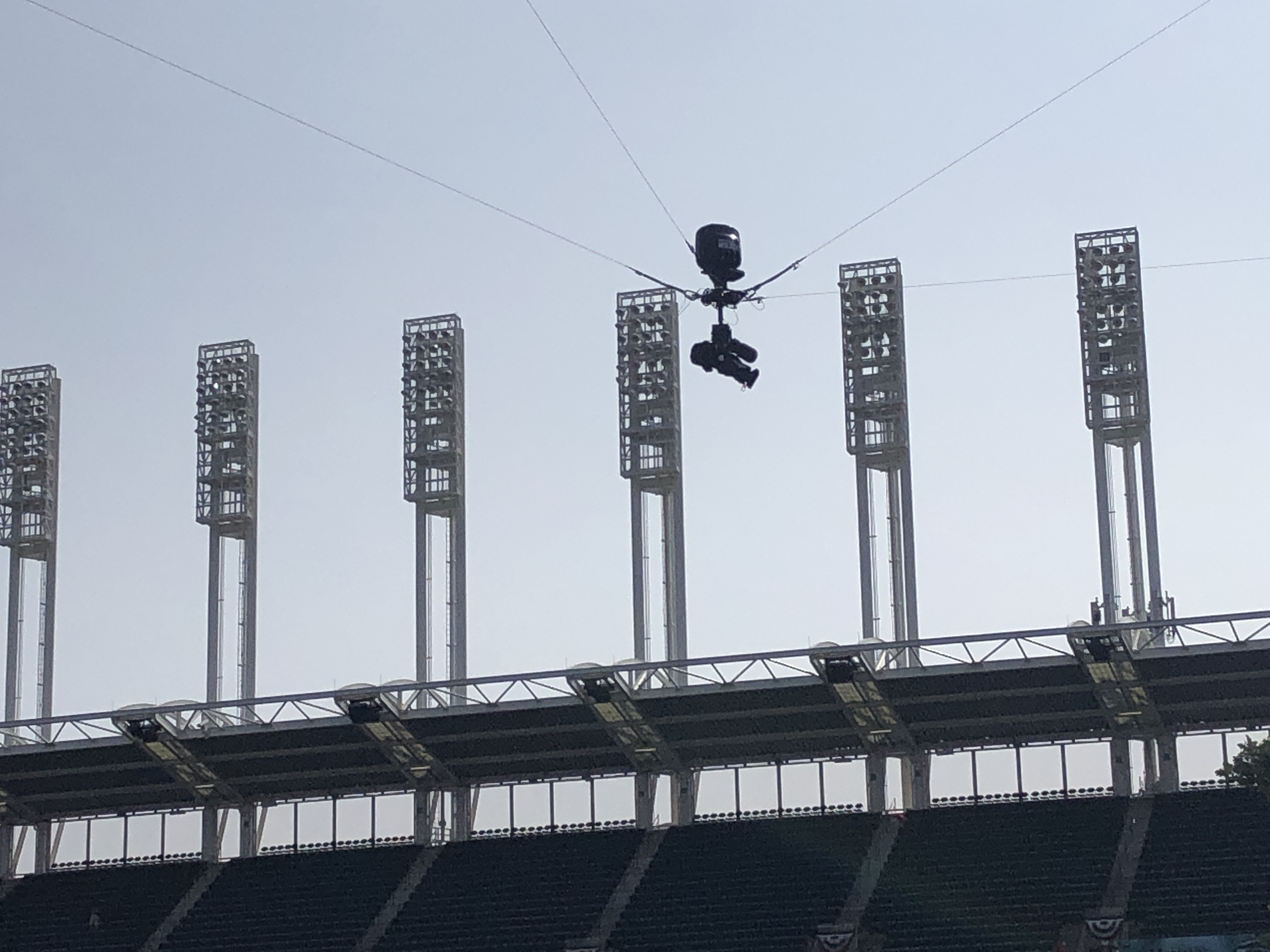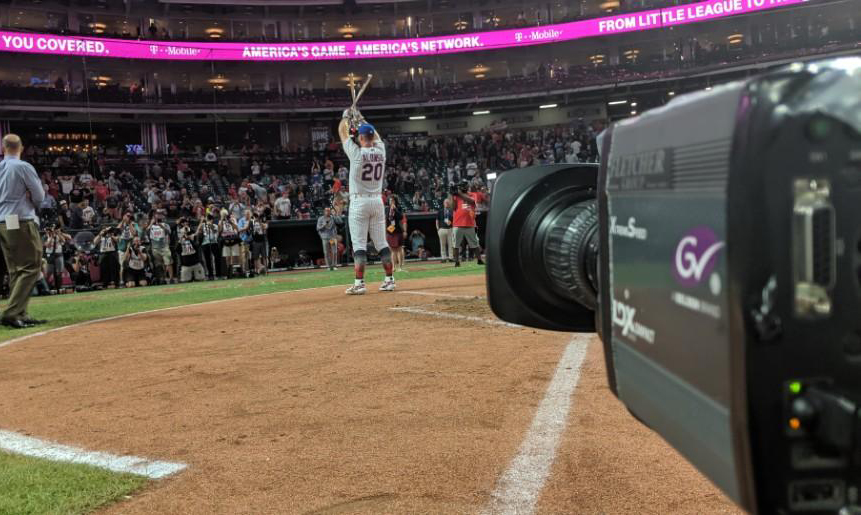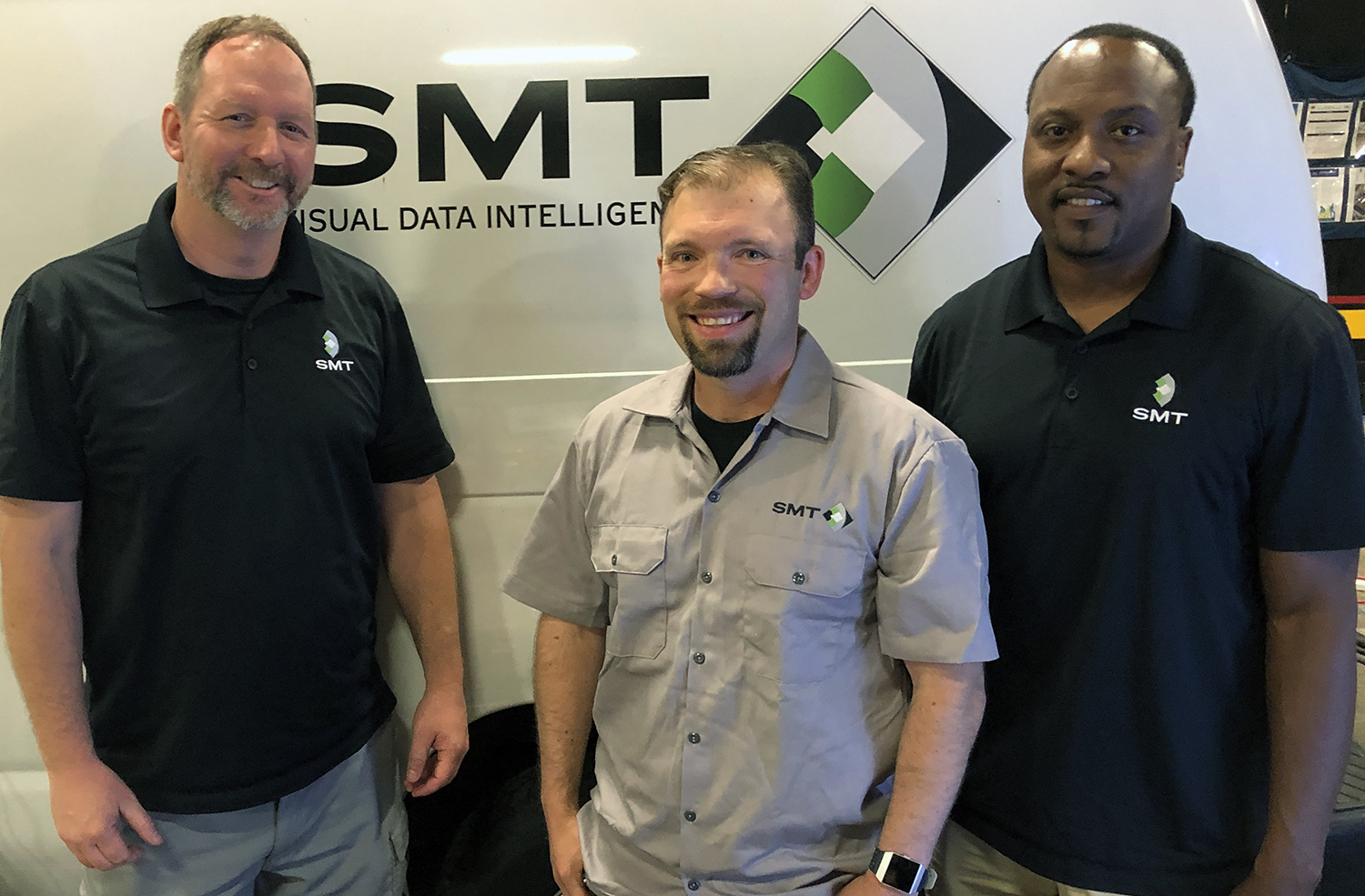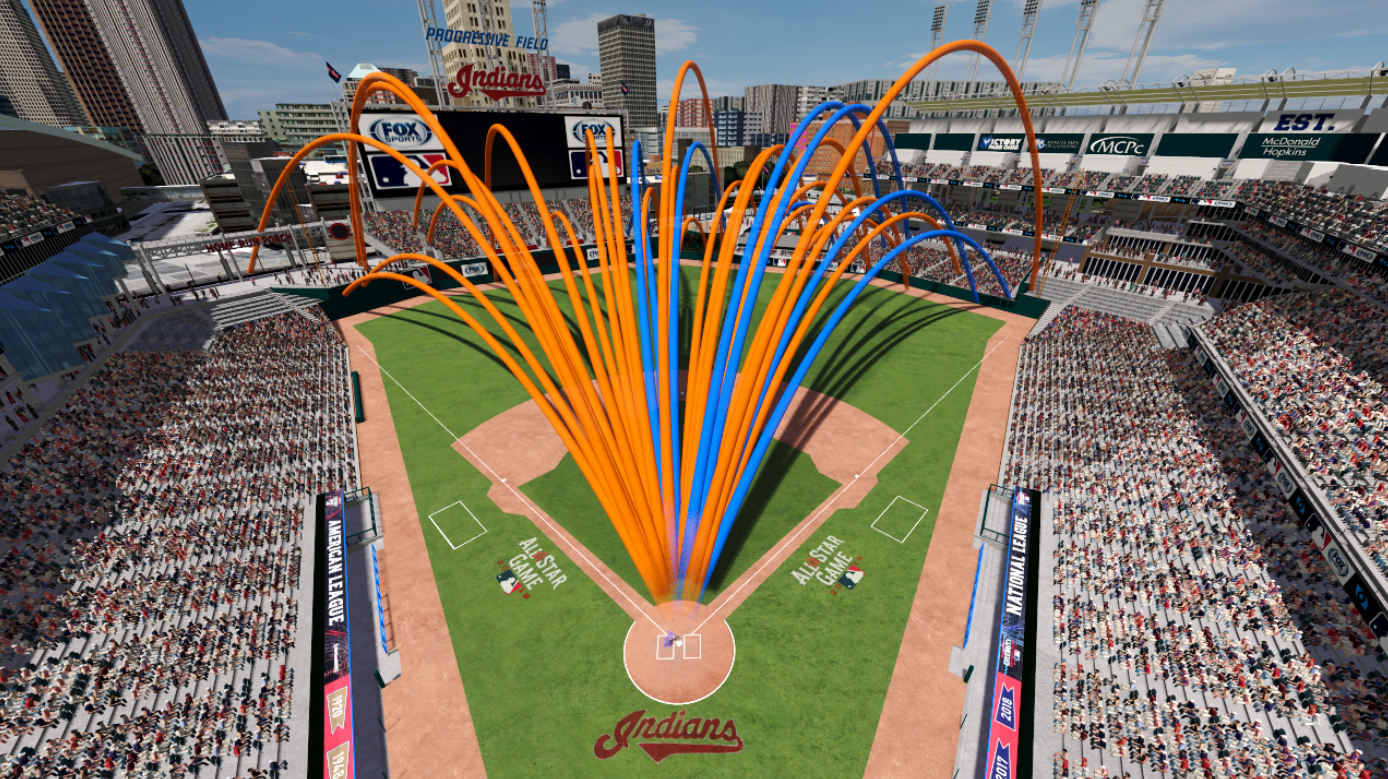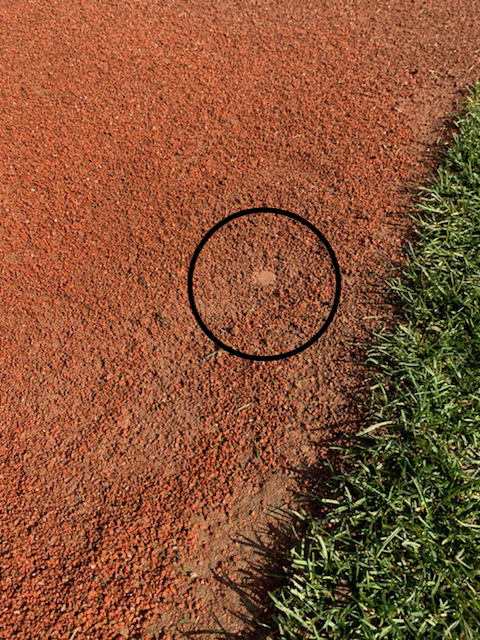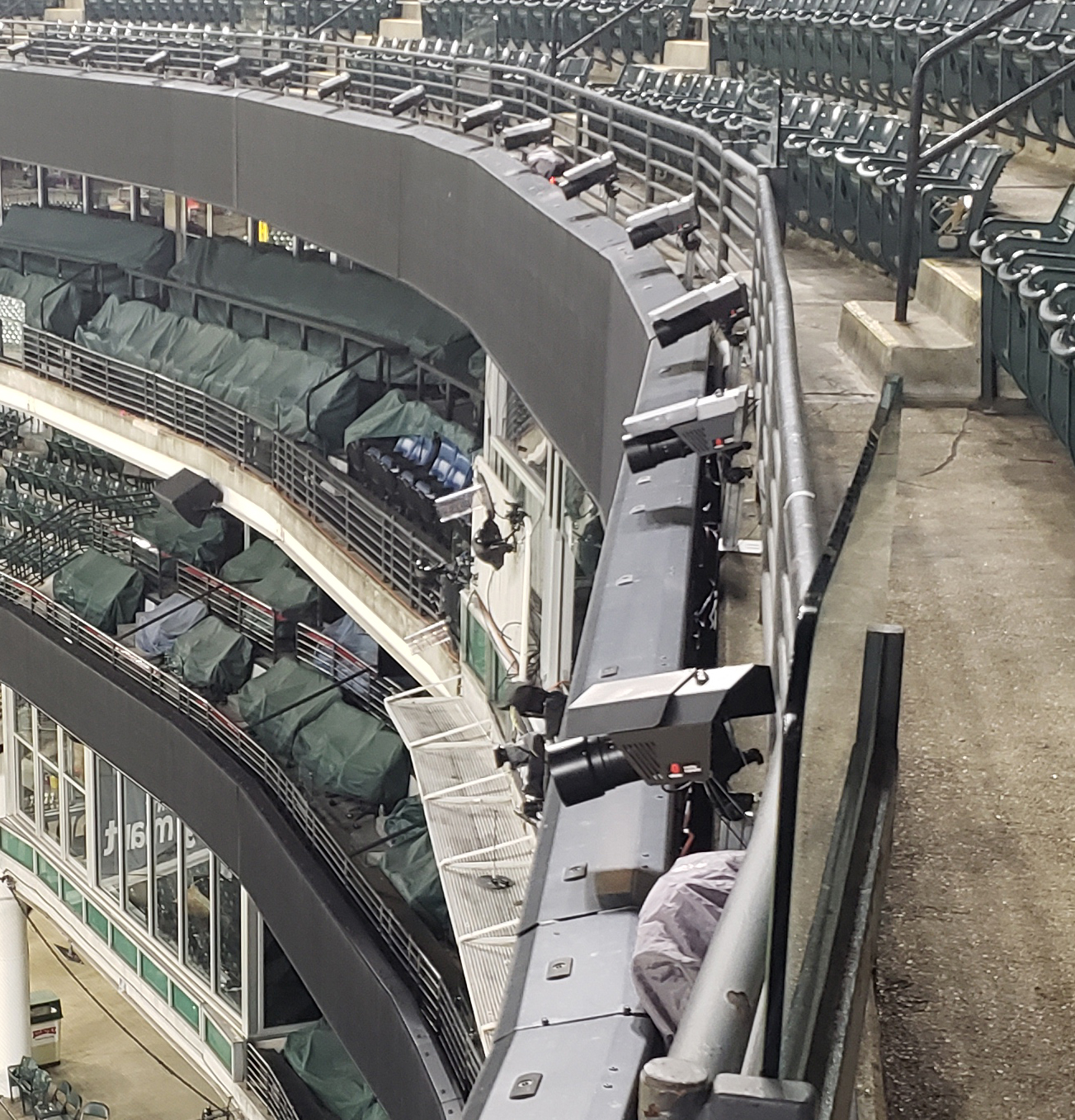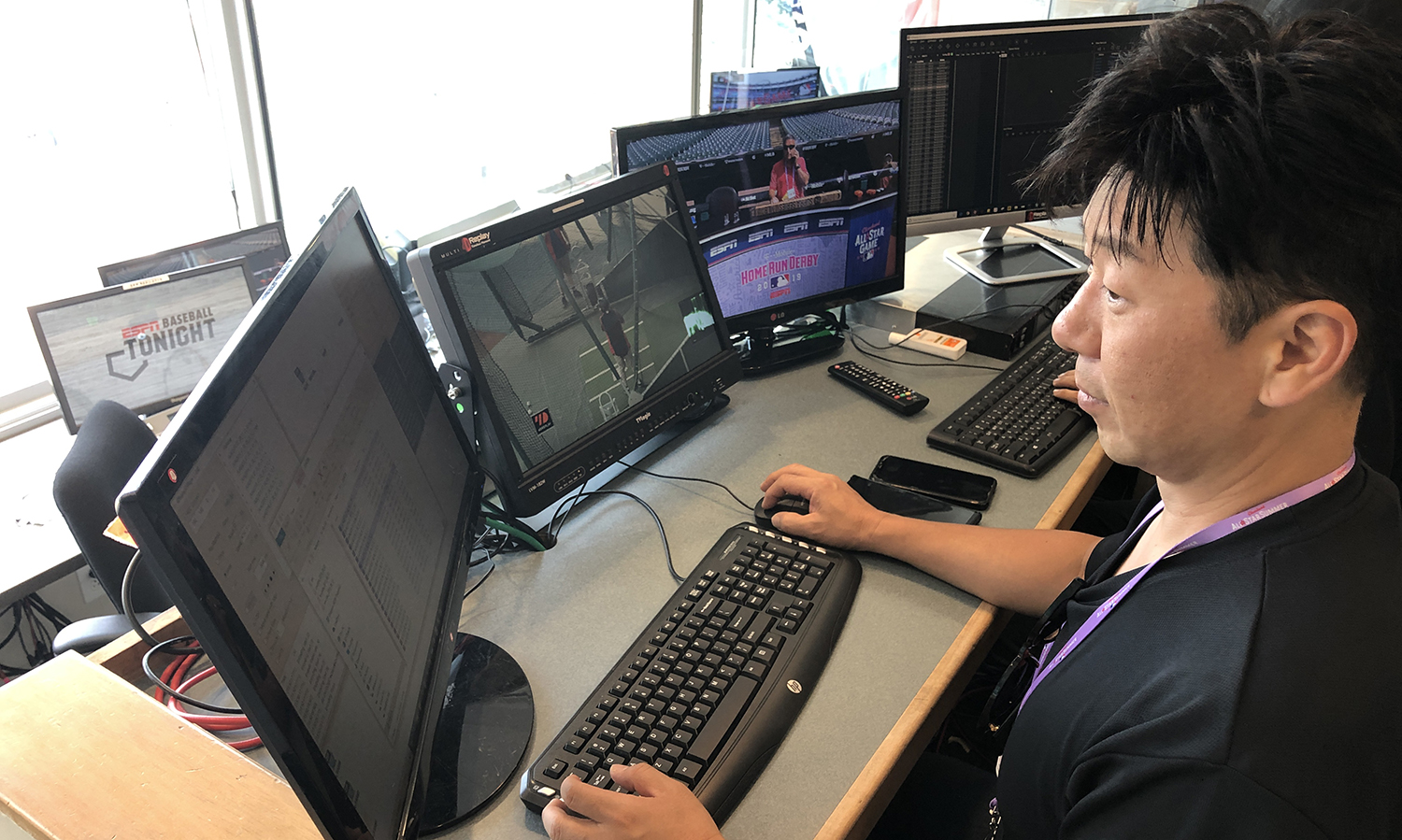MLB All-Star 2019 Wrap-Up: Specialty Cameras, Virtual Graphics Take Center Stage in Cleveland
A recap of the efforts by CP, Skycam, Fletcher, Admiral Video, SMT, Virtual Eye, Inertia Unlimited, and 4DReplay
Story Highlights
MLB All-Star week once again featured a cavalcade of specialty cameras, unique audio solutions, and virtual graphics to capture and enhance coverage by Fox Sports, ESPN, and MLB Network. Here’s a look at the roles played by some of the key vendors onsite in Cleveland to make it all happen: CP Communications, Skycam, NEP Fletcher, Admiral Video, SMT, Virtual Eye, Inertia Unlimited, and 4DReplay.
CP Communications Shoulders RF Load
CP Communications, a longtime veteran at MLB All-Star week, provided RF cameras, microphones, and comms and also handled frequency coordination for the broadcasters onsite.
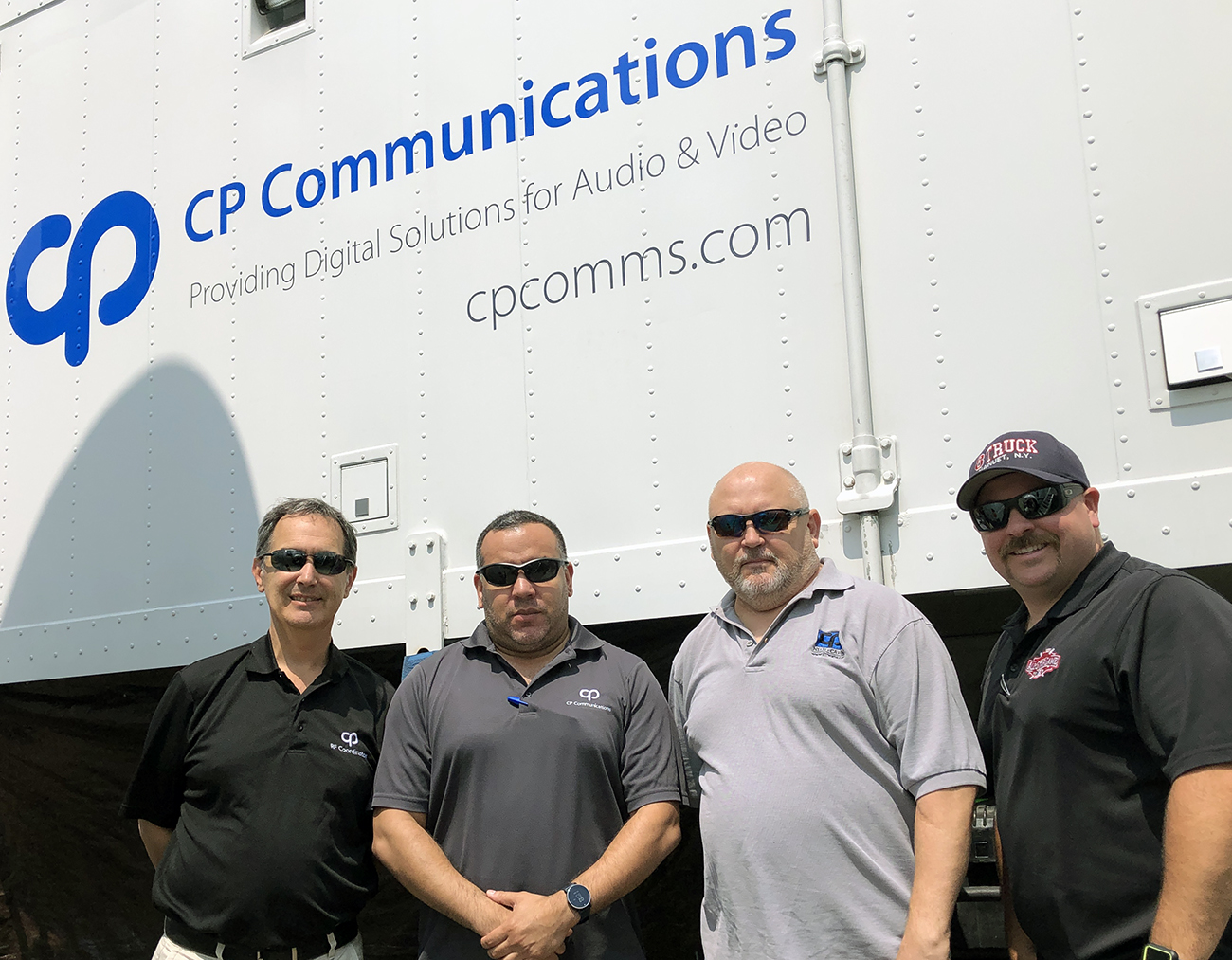
The CP Comms team at MLB All-Star (from left): Michael Mason, President; Aaron Segarra, VP Sales; Frank Rafka, Technical Manager; Brian Ready, Systems Engineer
The company supplied 14 RF camera systems in total, including handling RF for two new systems for ESPN’s Home Run Derby coverage: the Flycam point-to-point aerial system and the CartCam escorting players from the underground batting cages to home plate.
“The challenge of the CartCam was that the cart is not outside where our normal receive sites are, so we added receive sites downstairs,” said Frank Rafka, technical manager, CP Communications. “This is similar to the [cart] system we use in our golf [coverage], and it gives us the ability to route multiple receive sites to receivers. We have a receive site up at the top of the parking garage for the Flycam, and we have a receive site down in the tunnel to receive that CartCam. The beauty of it is, any of the cameras can go to any of these places. It’s not limited to just the Flycam or the CartCam: if the handheld needs to go into the hallway, it can do that.”
CP also supplied an RF Steadicam and three handhelds for ESPN; an RF MōVI rig featuring a Sony HDC-P1R camera and a Sony HDC-2500 handheld for Fox Sports; three handhelds — one of which was for MLB Digital — and two RF systems for the batting cages for MLB Network. In addition, CP deployed three Mobile Viewpoint bonded-cellular systems for MLB Network’s coverage of the Red Carpet Show.
On the audio side, CP supplied Fox Sports with 16 RF inground mics, RF talent mics, two RF ump mics, six RF player mics, two RF player IFBs for in-game interviews, eight RF FX mics, and RF mics on the bases. ESPN deployed CP reporter mics, field EFX mics, in-ground mics, player mics, IFB, PL, and RAD. For MLB Network, CP provided Dante networked audio and Shure Axient Digital mics. CP also provided a combined six Dante audio networks for the needs of broadcasters and operations onsite.
“The big thing this year is, there’s more Dante networked audio from all clients than there has been in the past,” said Brian Ready, comms engineer and client support, CP Communications. “Each client would individually do their own little thing, but now each one of them has grown. And so everybody is doing more and more Dante networked audio. Dante has grown by leaps and bounds.”
CP also managed comms needs for all three broadcasters onsite, provided a Pliant Technologies CrewCom system for MLB Digital, and served other MLB properties onsite.
“In terms of comms here, we’ve become a hub for all the networks, as well as MLB [Office of the Commissioner],” said CP Communications President Michael Mason. “We’re handling specific needs for [each broadcaster] and, at the same time, integrating all of them together. Not to mention also handling all their other communications with a truck compound that is in the basement, so we have installed a series of repeaters inside and outside the ballpark.”
Skycam Back for Chapter 2 at MLB All-Star
After making its All-Star-Game debut last year in Washington, DC, Skycam returned for Fox Sports and MLB Network — positioned just behind the left-centerfield wall and used for both game coverage and beauty shots of the Cleveland skyline (as well as for coverage of the Tuesday’s Red Carpet Show on MLB Network).
“MLB wants none of our support cables in fair play,” noted Skycam COO/CTO Stephen Wharton. “This can be a bit of a challenge, but our goal was to give a variety of shots to both Fox and MLB focusing on the Fox Studio set, the center and left-center fans, the bullpen area, and the Cleveland skyline. This versatility, along with covering the game from a higher angle from this location, allowed Fox and MLB Networks to get a lot of use and different looks across all their shows.”
With its MLB All-Star experience, the Skycam operation ran smoothly in Cleveland, according to Wharton. Since Skycam covers several shows over three days on both Fox and MLB Network, it was imperative that everyone was aware of the schedule and that comms and shading operations were adjusted accordingly. To make this happen, Skycam was able to assign an EIC to each network to maintain a single point of contact for the broadcasters.
“I think, logistically and technically, you always walk away from a show learning another trick on how to streamline,” said Wharton. “[In] our second year back, it helped MLB that they were already familiar with us and our setup: they knew exactly what we would be doing, and so approvals went very quickly.
“We’re still growing in the baseball space with the networks and the leagues,” he continued. “We have bigger plans to do more — like AR graphics and fly [Skycam] further onto the field — but it’s a crawl-walk-run scenario. We look forward to expanding our coverage into baseball.”
NEP’s Fletcher Supplies 14 Robotic Systems
This was Fletcher’s first MLB All-Star week under the NEP umbrella. The specialty-camera provider rolled out at total of 14 robotic systems for ESPN’s Home Run Derby and Fox Sports’ All-Star Game coverage, including the new Fletcher Boom robotic system for the Derby. The televator robotic system features a Sony HDC-P1 camera with a 40X lens behind the pitcher near second base and rises to about 13 ft. when raised and is as low as 6 ft. when lowered.
“Our camera complement is very similar to other HR Derby/All-Star years, but we do have a new addition to the HR Derby: the Fletcher Boom robotic system,” said Gabe Aguirre, senior account manager, Fletcher. “We are excited to add a televator robotic system with a Sony P1 camera with a 40X lens that will add a new angle behind the pitcher.”
Besides the Fletcher Boom system, the company provided ESPN with two Grass Valley LDX C86 robotic high-speed camera systems on the first- and third-base lines, three Sony HDC-P1 robotic systems at mid-home along with a robo in high left field and a roof robo in right field. Fletcher also deployed an I-MOVIX Phantom 4K robo system to capture the home-run swings.
Fox Sports used seven Fletcher robotic systems outfitted with Sony HDC-P1 1080p cameras at mid-home, in both dugouts, in the booth (traditional booth cam), mounted in the booth and capturing a wide shot of the field, in high left field, and on a roof in right field.
Admiral Video Serves Up a Dozen Pod Feeds From Media Day
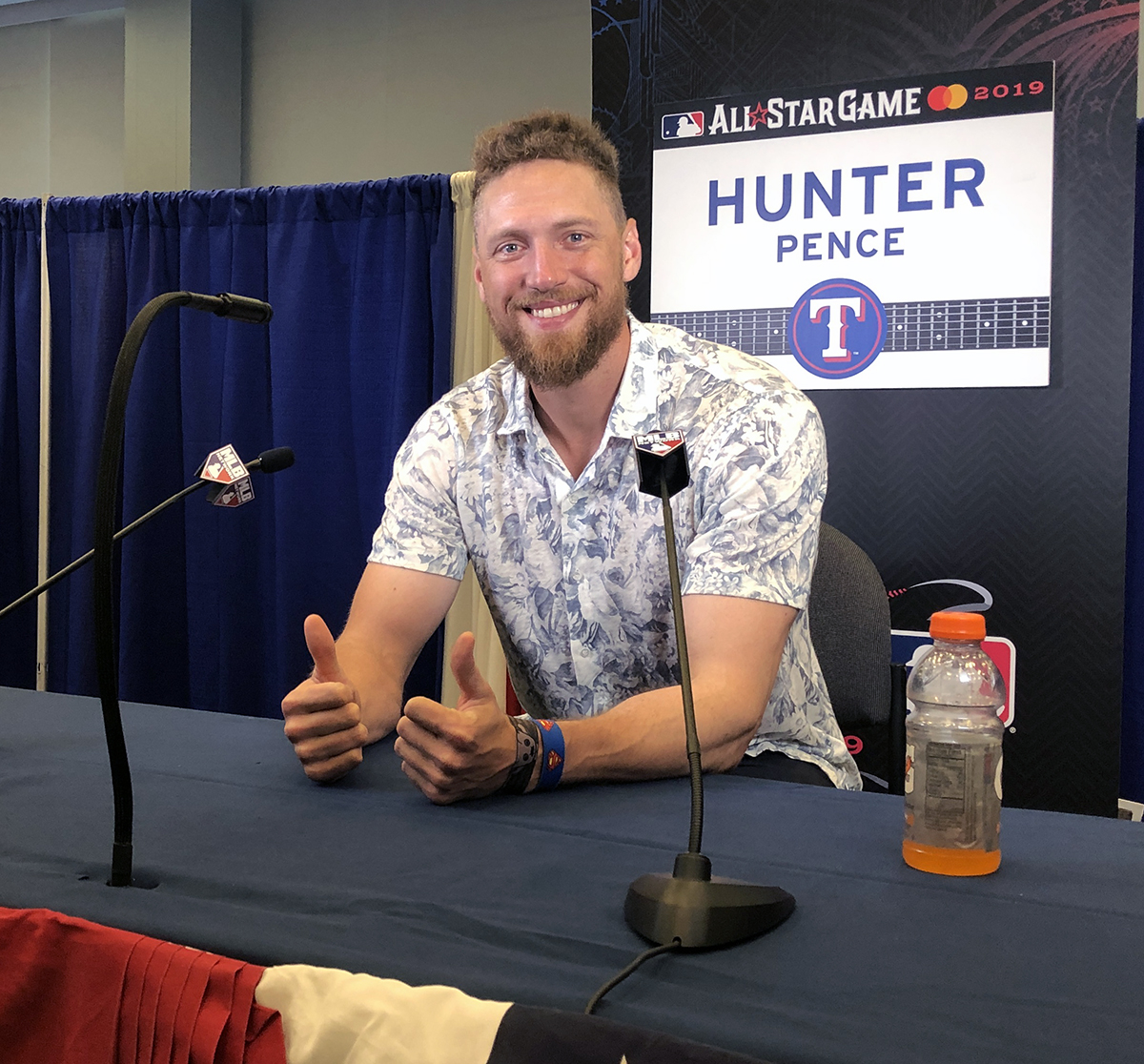
MLB Network’s Media Day operation featured 12 Admiral Video gooseneck cameras at player pods, including Hunter Pence’s
MLB Network’s All-Star Media Day operation continues to grow each year. The network once again worked with Admiral Video to deploy 12 Marshall miniature gooseneck robotic cameras on interview pods (plus a robo overseeing the entire room) for Media Day on Monday. The 12 feeds were used for MLB Tonight’s linear telecast covering Media Day and were streamed on MLB.com and each player’s team site.
The systems married the audio from two mics at each pod and fed the signal to a flypack created by MLB Network (instead of using Admiral Video’s truck as it did last year) at Progressive Field, which is about a mile away from Cleveland’s Huntington Convention Center.
SMT Virtual Signage Offers Fox Advertisers Flexibility
Always a fixture at big Fox Sports events, SMT was on hand providing virtual signage behind the plate for Camera 4 (the primary pitcher/batter camera) and tight center field. For the fourth straight year, the company also integrated its system with the high-home position, inserting virtual signage on the batter’s eye in center field.
“Fox likes having the batter’s-eye version for these [marquee] events like the All-Star Game and postseason because it gives the advertisers more flexibility,” said SMT Media Production Manager Peter Frank, who led a three-person team onsite. “There are a lot more eyes on this show than there would be on a normal Saturday MLB show, so we want to give them as much flexibility as possible.
“The technology used for [virtual] advertising is very fluid,” he continued. “Up until the very last minute, [advertisers] can be changing the look of their ad, and it will get processed and put on the air. They could have one look in the first inning and then switch it up and have a whole new look for the third inning.”
Virtual Eye Shot-Tracking Goes From Tee Box to Ballpark
Fox Sports worked with Animation Research Ltd (ARL) to bring to baseball the Virtual Eye graphics system that has become a staple of the network’s U.S. Open golf coverage.
The Virtual Eye team was provided MLB ballpark data to create a 3D virtual representation of Progressive Field and the surrounding area in downtown Cleveland. For the All-Star Game, the system leveraged MLB Statcast tracking data to provide AR graphics that tracked and compared pitches (for example, fastball vs. curveball), home runs, and other key elements in the game.
“We’ve got all the tracking data of the ball off the bat and all the pitches coming in, so we can basically visualize anything you can think up,” said John Rendall, project manager and head of technology and innovation, Animation Research Ltd/Virtual Eye. “For example, we can compare all of Aaron Judge’s home runs from last year and fly around the [ballpark] and show the data [visualization] in a number of different ways. The same with pitchers: we can compare curveball and fastball and show you the split to demonstrate how the two [pitches] look different to the batter.”
These packages were provided to the production team to integrate into the telecast as either full-screen or side-slab graphics.
Inertia Unlimited Resurrects DirtCam for Fox
The All-Star Game saw the return of DirtCam after a three-year absence, with Inertia Unlimited camera systems buried at home plate, at first base, and, for the first time, at second base.
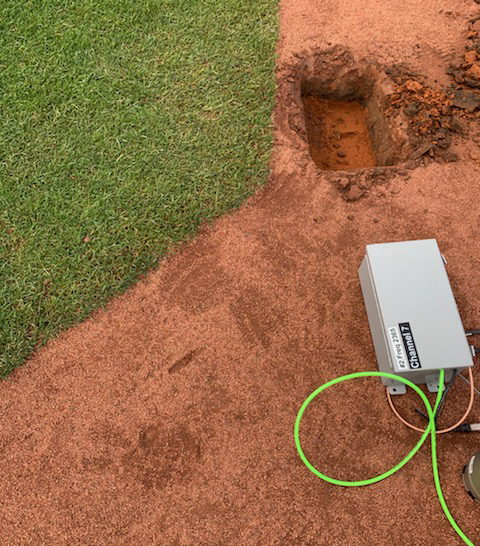 Previously used at an All-Star Game in 2016, the system now features a new prism that dramatically improves the system’s picture quality. The only part of the system above ground was the 4-mm prism (with a ½-mm sapphire window to make it waterproof), which was painted to perfectly match the color of the Progressive Field infield dirt and was almost imperceptible to the naked eye.
Previously used at an All-Star Game in 2016, the system now features a new prism that dramatically improves the system’s picture quality. The only part of the system above ground was the 4-mm prism (with a ½-mm sapphire window to make it waterproof), which was painted to perfectly match the color of the Progressive Field infield dirt and was almost imperceptible to the naked eye.
“I would call this DirtCam version 1.5 and the .5 is a new prism, which is the linchpin of the camera,” explained Inertia Unlimited President Jeff Silverman. “It’s essentially a normal point-of-view camera shooting through a tiny 2-mm hole using a mirror. [In the past], we had a lot of stadium lights shooting into the mirror and causing flares and other problems. Now we have a much better handle on controlling all that light going through a mirror.”
The systems used at first and second base have full pan-and tilt capability (home plate is a lock-off shot), allowing capture of a variety of angles along the base paths. The system is also entirely wireless, relying on unique underground RF transmitters that cannot be touched.
Inertia Unlimited also worked with CP Communications to develop an RF camera system attached to a golf cart that conveyed players from the batting cages to home plate during ESPN’s Home Run Derby coverage. The system featured a DreamChip camera (also deployed by Fox at the U.S. Open last month) that can be shaded using standard Sony RCP inside the NEP EN1 mobile unit used by ESPN.
“To my knowledge, this is the first use of the DreamChip camera with full paint [control] from a Sony RCP,” said Silverman. “We have a scheme that takes this protocol and turns it into Sony protocol, which means that we can now move [the video signal] via RF. Once we can move it via RF, it becomes quite a useful tool. And the camera looks spectacular. If you don’t look very closely, you might not even notice it was a POV camera, and yet it’s small enough to close your hand around. It’s definitely the most impressive POV camera I’ve seen in years.”
Inertia Unlimited also provided Fox two Phantom high-speed camera systems running at 2,000 fps.
4DReplay Returns to Derby, Debuts at All-Star Game
The 4DReplay system was back for a second go-round at MLB All-Star, returning for ESPN’s Home Run Derby coverage and making its debut for Fox Sports during the All-Star Game.
The 4DReplay system relied on 60 4K cameras mounted on the concourse level behind home plate and stretching from first to third base. The cameras were tied together, and, for each play, a single operator selected the pivot point on which the camera axis turned. The operator could manipulate the replay from side to side and zoom in without losing resolution (thanks to 4K). Since 4DReplay simply stitches together 60 camera feeds and does not have to virtually create filler frames, no rendering was required, allowing clips to be ready in under 10 seconds and sent on to the EVS replay room in the truck.
In addition, ESPN analyst Eduardo Perez was provided the 4DReplay tablet app for the “Statcast Edition” production airing on ESPN2, allowing him to control the replay system himself.
ESPN is continuing to enhance its partnership with 4DReplay. Having been deployed at the Derby and last month’s College World Series, the system is being used at the Little League World Series and five MLB games, including last Sunday’s Dodgers-Red Sox Game at Fenway Park (the system was also used by Fox and Facebook for Friday/Saturday games in the series) and Yankees-Red Sox in Boston on July 28.
“It’s very exciting right now, and we have a lot more [events] coming,” said 4DReplay COO Henry Chon. “We are going to have a big announcement in Europe soon, and we are going to be at one of the largest [sports events] in the world next summer. We are building on the foundation that we’ve created so far in the U.S. and are expecting a lot more growth here as well.”
CLICK HERE for more of SVG’s Live From MLB All-Star 2019 coverage.
